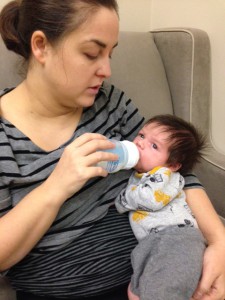 It is well known that alcohol consumption during pregnancy can harm the developing fetus. The placenta is not a barrier for toxic substances and even moderate drinking can cause devastating brain damage. But what about breastfeeding? Does that glass of wine you enjoyed with dinner pass into your breast milk? Do you need to be cautious about drinking alcohol?
It is well known that alcohol consumption during pregnancy can harm the developing fetus. The placenta is not a barrier for toxic substances and even moderate drinking can cause devastating brain damage. But what about breastfeeding? Does that glass of wine you enjoyed with dinner pass into your breast milk? Do you need to be cautious about drinking alcohol?
The short answer is “yes.” The alcohol you consume enters your bloodstream almost immediately and, therefore, is in your milk rather quickly. Even though the alcohol does transfer to your milk, the amount of alcohol your baby experiences is much less than the amount you drink. Unlike the placenta, the breast provides some protection from most toxins in your bloodstream. According to Dr. Thomas Hale, the dose of alcohol in milk is less than 16% of the mother’s dose. Continue reading


